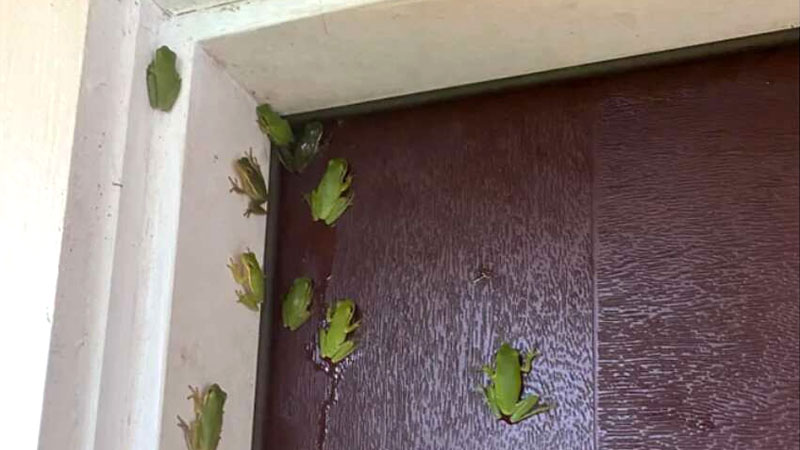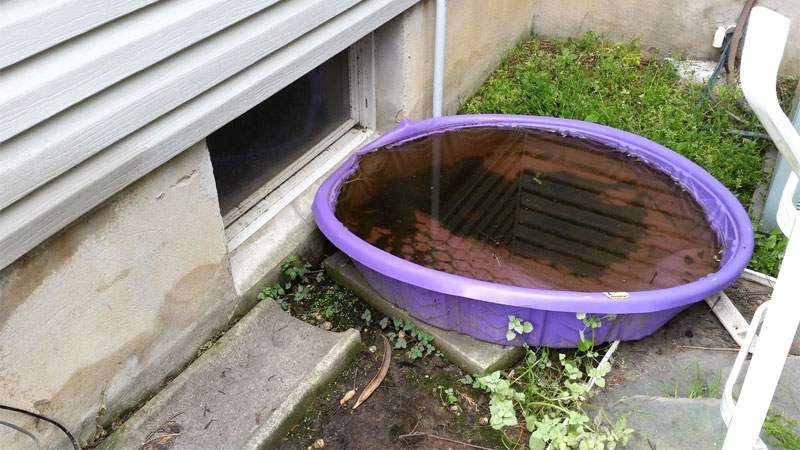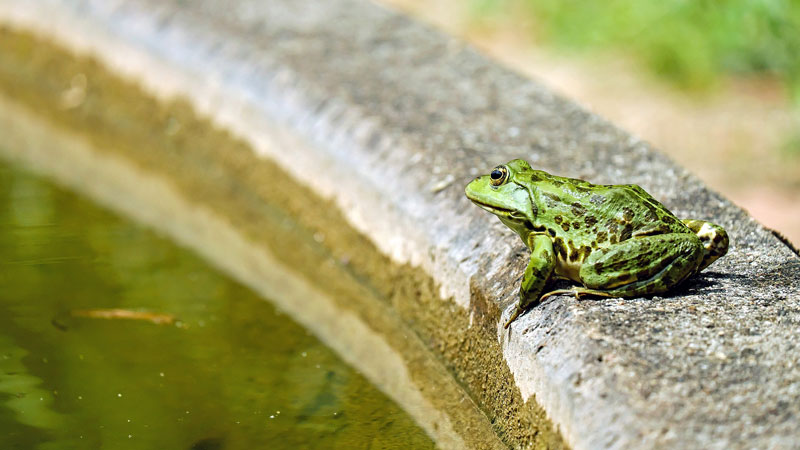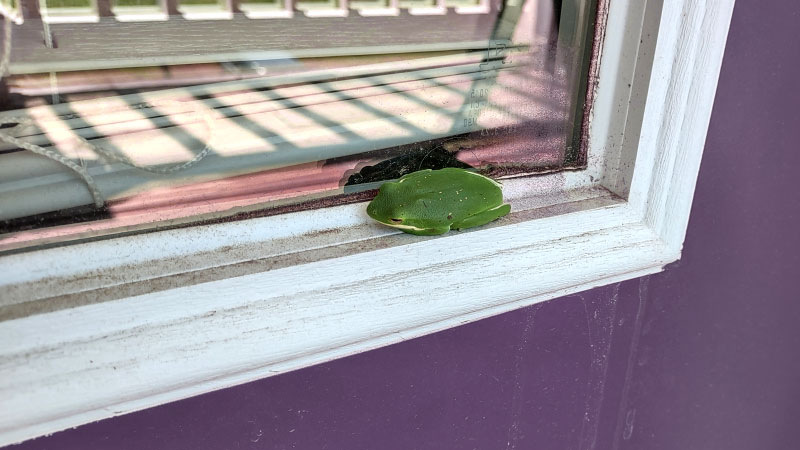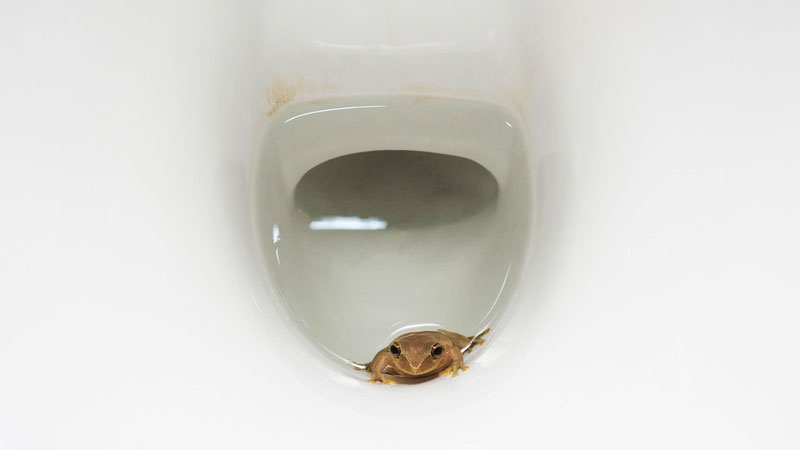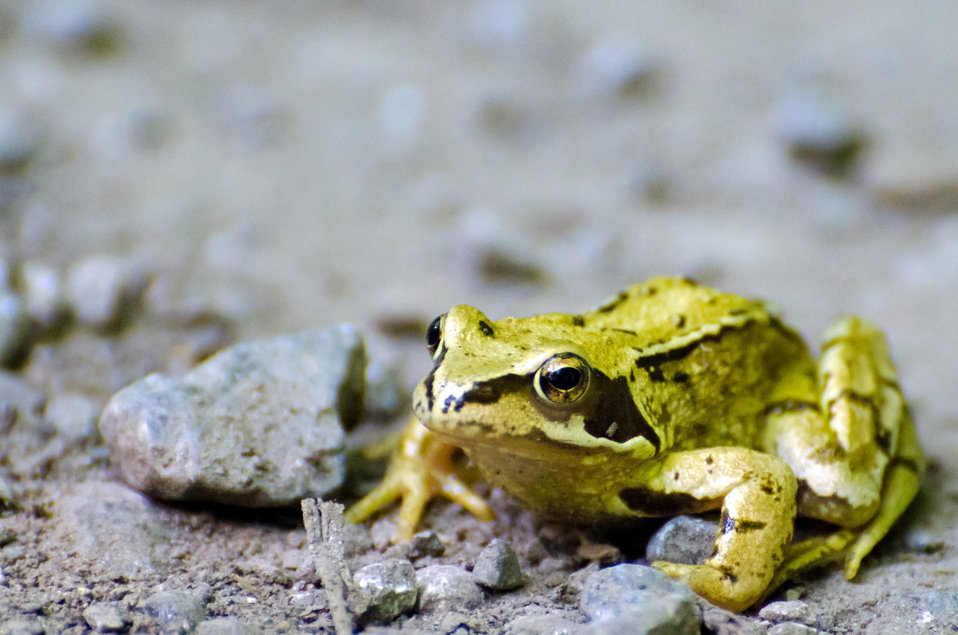There are many pros and cons to having frogs on your property. But sometimes the frog population begins to get too big for the insect population to provide adequate food.
Knowing how to prevent frogs from entering house and home isn’t some well-kept secret. However, it can seem like an uphill battle if you aren’t used to living around frogs.
Here’s everything you need to know about why they might want indoors and how to stop them.
What Attracts Frogs Inside?
Before we can discuss how to prevent frogs from entering home spaces, it’s necessary to figure out why they might want to get in.
Things that Attract Frogs to Your Property
Frogs need several things to thrive, including food, water, and shelter. While availability may fluctuate outdoors, all three are often available all year inside your home.
Food
Frogs eat all sorts of pests, from bugs to slugs and even small rodents, if the hopper is big enough. They might be welcome for a while, but their voracious appetite means that they can eat a huge amount of insects every day.
Eventually, those numbers will diminish, causing your hoppers to look elsewhere for food.
Water
It’s also not uncommon to see more frogs appear after it rains. As the ground dries, many will seek new sources of moisture, which may include your home.
Note that toads (which are a nickname for frogs with bumpy, dry skin) often prefer drier conditions and may stick around longer.
Most (but not all) species of frogs need standing water to lay their eggs. The baby frogs of these species hatch as tadpoles, which depend on water until they begin growing legs.
However, there are actually a few species which don’t have a tadpole stage and lay their eggs on land.
Shelter
Finally, these little hunters have plenty of natural predators such as snakes and birds. They’ll actively seek out shelter in dense plants, under rocks, or even burrow into the ground.
It’s not uncommon to see them scatter for new sources of shelter after you do yard work or gardening.
Likewise, the risk of an invasion increases during particularly hot or cold weather when better shelter may be necessary.
Why are they Entering My Home?
An indoor frog infestation almost always happens when there’s a deficiency in the outdoor habitat for frogs.
Water and Nesting
Sometimes a water source will dry up, which affects smooth-skinned frog species worse than it does toads. They may try to enter your basement or septic tank looking for a new source of standing water.
Food
Another common reason is that the insect population is no longer large enough to sustain the amphibian population, forcing them to look for other sources of food.
Light is also a major attraction for frogs, because in their natural habitats, this is where the bugs are. When you don’t have outdoor lights on, they may try to enter a lit room through your windows in search of food.
Shelter
Excessive trimming can chase tree frogs from their shelter, causing them to look for a safe replacement. Yard work can also scare burrowing species out of hiding.
In both cases, they might see your home as an alternative source of shelter.
Temperature
Finally, extreme or sudden shifts in temperature can drive the hoppers indoors. Because they are cold-blooded, they need a place to stay somewhat warm to survive the winter.
In the summer, extreme heat can dry their skin too fast, affecting their ability to hunt.
How to Stop Frogs From Entering the House
So now that we know why these critters may want to become housemates, let’s look at ways to keep them from getting inside. These little tricks not only stop frogs, they will help prevent other pests from entering too.
Create a Dead Zone
Making a “dead zone” barrier is one of the easiest, most ignored methods out there. Remove or trim all plants so there is a six-inch gap between your foundation and the nearest plant.
Cover this space with coarse sand or another fine aggregate so nothing can grow there. You want the granules to be small so bugs can’t hide between them.
Also, you can use a chemical barrier treatment for a second line of defense. So what does this do?
It creates a small, open desert that bugs are afraid to cross because it exposes them to predators.
Since the bugs are avoiding your home, frogs and other predators have less reason to approach your walls.
Drain the Pool
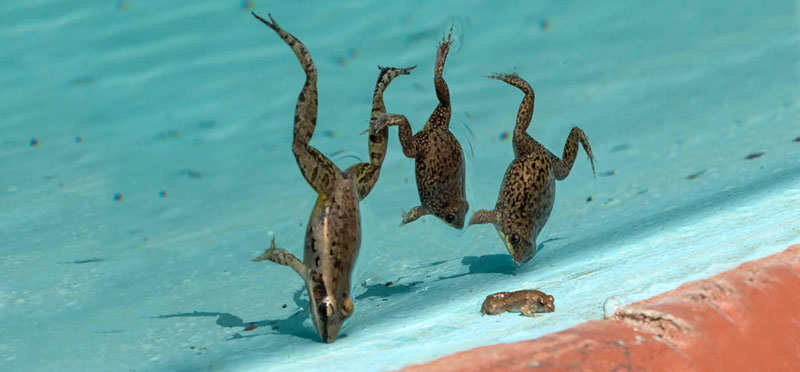
Keep your swimming pool drained when you aren’t planning to use it for a while. A fitted pool cover can also keep pests from accessing the water during swimming season.
Fill in any spots on your property prone to forming puddles and remember that bird baths can serve the same function as your pool.
If you have water features, make sure the water is moving by using a pump or adding a little waterfall. Natural bodies of water are a more difficult problem, but you can keep the shorelines free of plants or other shelter.
Install Door Sweeps
This trick mainly applies to older homes where there’s often a small gap under the door. The door sweep is a rubber or plastic barrier that covers this gap without interfering with the door’s movement.
Not only are these a great way to keep critters out, they can also keep warm or cool air in, saving you money.
Maintain Gardens and Landscape
Let’s face it, the main reason to invite these critters to your garden is for natural pest control. Garden bugs are a natural buffet for frogs, but when there’s no food, it’s time to evict any excess frogs.
A good rule of thumb is to regularly weed and keep lawn grasses under three inches tall. This not only removes the amphibians’ shelter, it reduces the insect population.
Companion planting and other natural methods of insect control can also discourage a large hopper infestation.
Tell Them Nobody’s Home
Keep windows and doors closed if they don’t have proper screening. When you’re not outside, turn any exterior lights off to deter bugs.
While these seem like common sense, a little hopper or wolf spider can easily slip inside if you’re holding the screen door open while carrying groceries or furniture inside.
Seal Entry Points
Entry points are any gap or opening that’s big enough for a pest to get through. These include vents, tiny holes in your outer wall, broken caulking around windows, and gaps around pipe or wire entrances.
These should all be properly sealed, not only to keep pests out, but also to improve your heating bills. You can hire a professional carpenter to use a colored smoke bomb and expose entry points you might otherwise miss.
Purchase vent covers to safely block these important openings and make sure the screens on your windows and doors are all intact.
Finally, check the caulking around doors and windows, patching where necessary.
How to Get Rid of Frogs Around Your House
So what happens if one of these little guys get inside? Thankfully, there are many ways to safely remove them.
Important: Wear Gloves
While most frogs in the US aren’t dangerous to humans, there are species that can poison your pets. These can also cause mild irritation if you handle them.
There’s also a bacterial risk from wild frogs, so wearing gloves can help protect you and your family.
Locating the Frog
The first step is to locate your little intruder. There are a few ways to do this, although they may require a bit of patience.
Baiting Them
You don’t need to use poison on a hopper. Instead, dampen a paper towel and put it somewhere dark that they can access, such as a closet.
Quietly peek in occasionally to see if anyone’s come looking for moisture.
Alternatively, you can grab a few dead flies from your bug zapper (or the victims of your latest Bug-A-Salt hunting spree) and place them as bait in a live trap.
A third option is to get a jar and put a little damp soil in the bottom. The frog will climb in but not have enough room to jump back out.
Check Your Plants
Pests tend to be where the food is, so houseplants are a common hiding spot for bug hunters. If you have a lot of plants, there’s a good chance the hopper is hiding there.
Leave a Light On
Nightlights can be useful in trapping several bug hunters, including frogs.
Leave your sink light or a nightlight on in a room you suspect the little hopper’s hiding. Chances are, they’ll be drawn to the light looking for food.
Listen Closely
Let’s say the other methods aren’t working or you suspect there are still frogs hiding around the house.
Wait for night and listen for sounds of croaking or movement. If your ears are good, you might be able to zero in on any unwanted guests.
Capturing the Invader
Once you’ve spotted your target, it’s time to catch it. Again, there are a few different options here.
Netting
An aquarium or pool net is the perfect tool for catching these little guys. You can also MacGyver your own net using an old pair of nylons and a coat hanger.
Creep up slowly on the critter and catch them in the net before they can hop away. Remember, frogs actually crawl around and tend to hop when in danger, so going slow will make your job much easier.
Using a Jar
A jar or other container can also be used to capture the little guy. This requires more skill, but still works really well and doesn’t require you to touch the frog.
Sneak up on the little guy, being careful not to scare it. Once in range, cover it with the container.
You can slip a piece of cardboard underneath so it can’t escape, then flip the container over for easier carrying.
Using Your Hands
If you aren’t squeamish, you can capture the hopper with your (gloved) hands.
Again, this requires a slow approach and a little skill. However, when nothing else is available, this remains an effective method.
Releasing the Frog
This is probably the easiest step. Simply take the hopper outside and release it, being careful not to let it out too close to your home.
Unlike mice, you can just pick a nearby water source such as a river or stream and they’ll be so hoppy they won’t return.
- How to Identify Skunk Poop (With Pictures) - April 1, 2024
- You Really Don’t Need That Opossum Trap - January 4, 2024
- How to Set a Mouse Trap Without Getting Hurt - December 28, 2023

